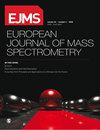Guest Editorial: Two Decades of LIFDI: Pedigree and Capabilities.
IF 0.8
4区 化学
Q4 PHYSICS, ATOMIC, MOLECULAR & CHEMICAL
引用次数: 1
Abstract
Liquid Injection Field Desorption Ionization (LIFDI) Mass Spectrometry (MS) became increasingly attractive to catalytic, inorganic, and organometallic chemists publishing more than 500 papers with LIFDI data during the last years. The extremely soft ionization of neutral compounds, the compatibility with non-polar solvents like toluene or hexane and last but not least the quick and convenient protocol under anaerobic conditions made LIFDI MS the method of choice for reactive compounds sensitive to air and/or moisture. The softness of the ionization is due to the fact that LIFDI is one of three Field Ionization (FI) methods which remove the weakest bound electron from neutral molecules literally without transferring excess energy to the hence stable radical ions. FI-MS was introduced by Inghram and Gomer in 1955 as the first of these methods (DOI: 10.1021/ja01607a096). FI mass spectra of hydrocarbons were essentially free of fragment ion peaks as opposed to Electron Ionization (EI) spectra. This made FI become a standard ionization method in the petrochemical industry. FI and EI have in common that only gases and vapours of compounds can be ionized. Therefore, the term FI-MS was soon associated with soft ionization mass spectrometry for the analysis of gases and volatile compounds. Field Desorption (FD) was introduced in 1969 by my venerated teacher Hans Dieter Beckey (DOI: 10.1016/ 0020-7381(69)80047-1). Using FI, he observed raising signal intensities along with the aging of the emitter wire. The notable increase in ionization efficiency was found to be correlated with the growth of tiny graphite whiskers via decomposition of acetone vapour on the hot surface of the wire. This process during tuning of the ion source raised the local field strength this strongly that up to 100 times more intensive signals appeared. When Beckey dipped a solution of D-Glucose onto an aged, i.e., “high sensitivity” wire, reinstalled the source flange, pumped down, and acquired the first FD spectra, he obtained the [M+H] ion signal as the base peak while fragment ion intensities remained at a negligible level. Thus, according to the title of the first FD paper, FD became the first ionization method for “the study of thermally unstable substances of low volatility”. LIFDI was introduced here in EJMS in 2004 (DOI: 10.1255/ejms.655). LIFDI outperforms FD by its convenient sample supply to the emitter right inside the ion source through a fused silica capillary without breaking the vacuum. LIFDI enabled a fully anaerobic protocol with the capillary aspirating sample solution under the inert headspace of a septum capped vial or directly out of the glove box (DOI: 10.1021/jacsau.1c00117). In conclusion, LIFDI, FD, and FI share the soft ionization of neutral molecules by “removal of electrons from any species by interaction with a high electrical field” (according to UPAC 1997). They differ in the way the samples are supplied to the emitter: in FI via the gas phase, in FD from solution applied onto the emitter outside of the ion source vacuum, and finally, in LIFDI through a capillary directly onto the emitter inside of the vacuum. I am honored and grateful alike for the occasion to serve as a guest editor to publish this special issue celebrating LIFDI-MS two decades after its introduction. Finally, I want to thank all scientist who agreed to publish their most recent findings in the field in this special issue of EJMS.客座评论:LIFDI的二十年:谱系和能力。
本文章由计算机程序翻译,如有差异,请以英文原文为准。
求助全文
约1分钟内获得全文
求助全文
来源期刊
CiteScore
2.40
自引率
7.70%
发文量
16
审稿时长
>12 weeks
期刊介绍:
JMS - European Journal of Mass Spectrometry, is a peer-reviewed journal, devoted to the publication of innovative research in mass spectrometry. Articles in the journal come from proteomics, metabolomics, petroleomics and other areas developing under the umbrella of the “omic revolution”.

 求助内容:
求助内容: 应助结果提醒方式:
应助结果提醒方式:


